(Here are part one and part two of my Giving Tuesday 2022 email fundraising and marketing analysis)
Let’s dive into the third post of my Giving Tuesday 2022 email fundraising and marketing analysis.
This week I’ll be sharing with you six takeaways related to gratitude, storytelling, countdown clocks, personalization, explaining the need and much more.
Let’s get to it!
Number 1: Gratitude = retention
I did not donate to any of the organizations that emailed me about their Giving Tuesday (GT) campaign. And I’m sure each charity had plenty of subscribers like me.
I’ll assume that when a subscriber donated online, they received an email thank you.
However, those personal gratitude emails should not prevent organizations from sending a gratitude email to their entire list. Thank your supporters. Let subscribers know the impact their collective donations will have. Make them feel the love.
Let me add: That thank you email should be 100% gratitude. It should NOT INCLUDE A FUNDRAISING ASK FROM THOSE WHO HAVE YET TO DONATE TO THE CAMPAIGN.
Sorry for the caps lock but it needs to be said. Let donors bask in the glory of doing something good before you jump to your next ask. Don’t let anything distract from the gratitude!
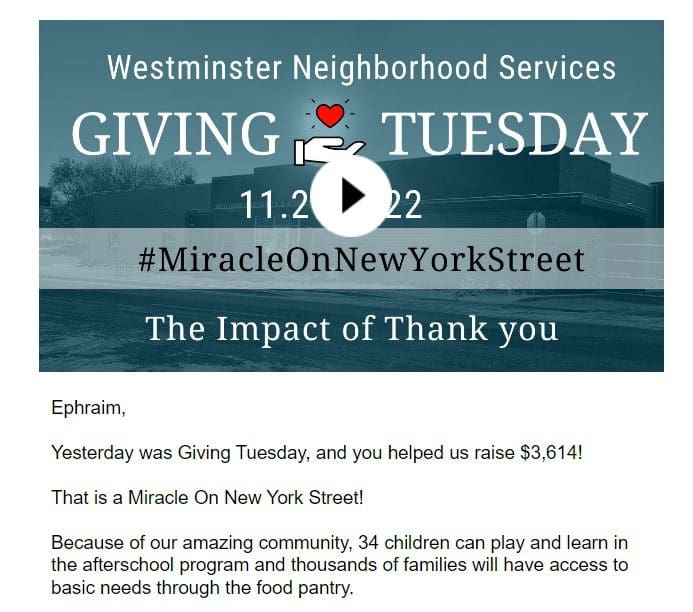
Kudos to Westminster Neighborhood Services who sent me a gratitude video the morning after GT. That’s how ya do it!
Out of 43 organizations who emailed me on GT asking for money, only 16 sent a general thank you to their entire list.
Not great.
Even worse: 13 of those 16 (81%) included a donation ask in their gratitude email. 🤦♂️🤦♂️🤦♂️
This is not the first time I’ve encountered this. I’ve seen it both on email and social media. Lack of gratitude is going to hurt your fundraising efforts. It’s simply not the way to go.
Takeaway I: Whether an email subscriber donated or not, send out an email to everyone on your list with a heartfelt thanks to your entire community of do gooders. Let them know the impact of their collective giving.
Takeaway II: Don’t use a gratitude email to make an ask!
Takeaway III: Send your gratitude email as soon as possible after the campaign. Don’t be like Project HOPE who sent me a GT thank you email nine days after GT.
Number 2: Here’s the story
Storytelling sits at the heart of all fundraising and marketing. And yet only 30% of organizations included a story as part of their GT ask.
As I mentioned in part one of this email analysis, the vast majority of emails were about the cash. They wanted money.
Stories connect donors to the people they’re helping in their community. It allows subscribers to meet beneficiaries, staff, volunteers and donors. Stories help bring an emotional tug to your pitch.
Kudos to Alex’s Lemonade Stand Foundation which included a story in almost all of their GT mails.
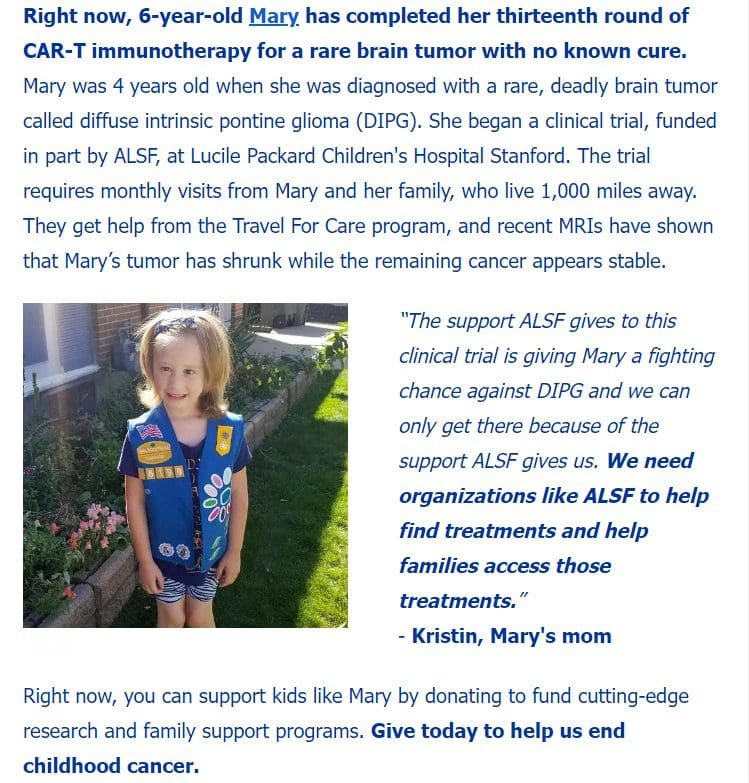
On the other hand, UNICEF sent me the following at 11:36am on GT: “Now, I’m sure your inbox is overflowing with emails just like this one but I hope that this is the email that compels you to give today. We’re not just asking you for money, we’re asking you to contribute to a child’s potential future.”
Know what their appeal was missing? A story! Tell me a story of a kid who needs my help or is succeeding because of a donation to UNICEF.
Takeaway: Use storytelling in ALL your fundraising and marketing campaigns.
When doing so, use what I call the “story of one.” Talk about one person who has a problem which needs solving and their story helps demonstrate the larger need.
Why story of one? When you tell an individual subscriber that 30,000 people in your city go hungry every day, they may think the problem is too large for their small donation of $25 to help. Means they’re less likely to give.
When you explain the problem through the lens of one person, the donor can connect with that person and know that their small donation will be able to help that individual.
Number 3: But I already gave!
One of the most frustrating things for donors is when they’ve already given but they keep receiving asks. It makes them wonder if your nonprofit is disorganized. They get worried that maybe their credit card was charged but the payment never went through.
There are ways to deal with this issue. With email, you can segment out of a send everyone who has already donated. You can also add to your emails and letters a sentence informing people that it takes time for your organization to process donations.
For example: Let donors know that if they’ve sent a check, it can take up to a week to process. Therefore, in the time between when they sent the check and you recorded it, they may have received another ask. But your organization is on top of things and will acknowledge their donation ASAP.
On email, see this example from The Nature Conservancy:

Or this one from Make-a-Wish:

Both of the above do a good job of keeping subscribers informed. This kind of language applies to ALL fundraising campaigns you run- whether it’s on Giving Tuesday, end-of-year or a campaign in mid-May. Keep donors informed!
This P.S. from Feeding America could be better:
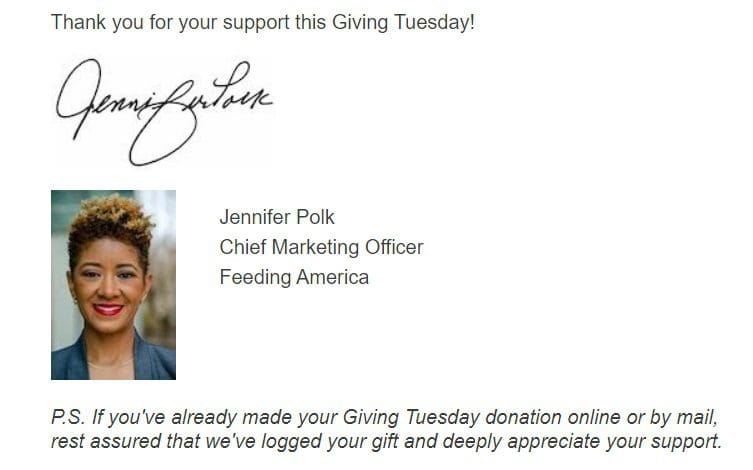
If they’ve logged my GT gift, why are they still sending me GT asks?!
However, you’ll notice that I included the email signature in the above image. That’s because it’s something you should copy. There’s an e-signature, name of person sending the email, their job title and headshot. This helps personalize the email and gives it a feel of one-to-one communication.
Takeaway: Use language in your asks that acknowledges that some people may have already donated. Let them know that you are working to process their gift quickly and they will no longer receive any more asks for the specific campaign.
Number 4: The first of her name
Email is a one-to-one conversation between your organization and an individual subscriber. This is why personalization matters.
Emails with a personalized subject line- they add my name- generate 50% higher open rates.
Think about that for a second: People’s inboxes are overflowing with emails (especially on GT!). Want your email to stand out and be opened? Use the subscriber’s name in the subject line.
In last week’s post I discussed the importance of using a subject line which will prompt me to open the email. And how most of the GT emails I received weren’t great.
Of the 271 GT emails I received, only 22 (8.1%) personalized the subject line. That’s way way too few!
Takeaway: It’s not difficult to do. As you send your year-end emails, add the subscriber’s first name to the subject line. It’ll help convince more people to open your email.
More opens = more opportunities for them to read your content and be encouraged to take action.
Number 5: The Backstreet Boys want you to tell me why
Just saying “we need X” will not help.
Explain the need! Tell readers why you need X dollars, who and how many people will be impacted. Share the story of one which encapsulates the need for donors.
Only 25% of the GT emails I received mentioned what they were raising funds for. Many of those emails had general explanations and didn’t provide further details.
But those details could be the difference between someone clicking to donate and someone deleting your email!
Take a look at this image in an email from Feed the Children:
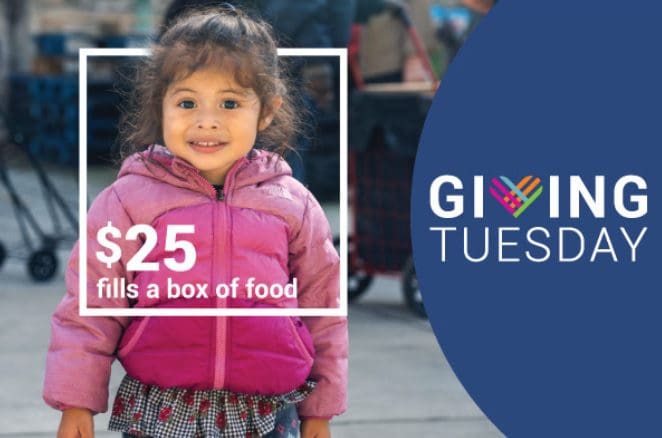
Great picture. Story of one. Tells me how much I need to donate and what the impact will be. Boom- I click and donate.
MAP International shared this prior to Giving Tuesday:
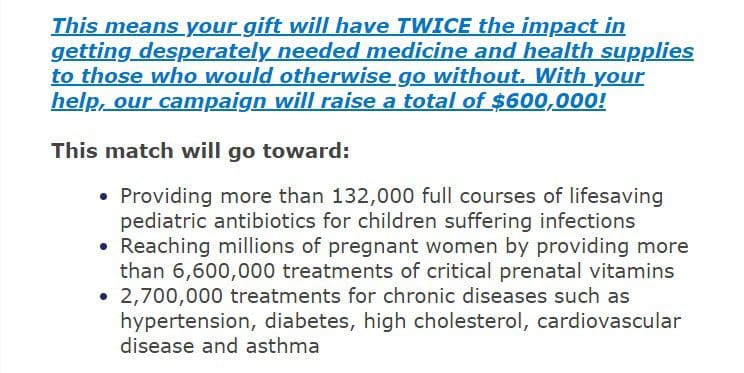
The American Lung Association shared this with their subscribers:
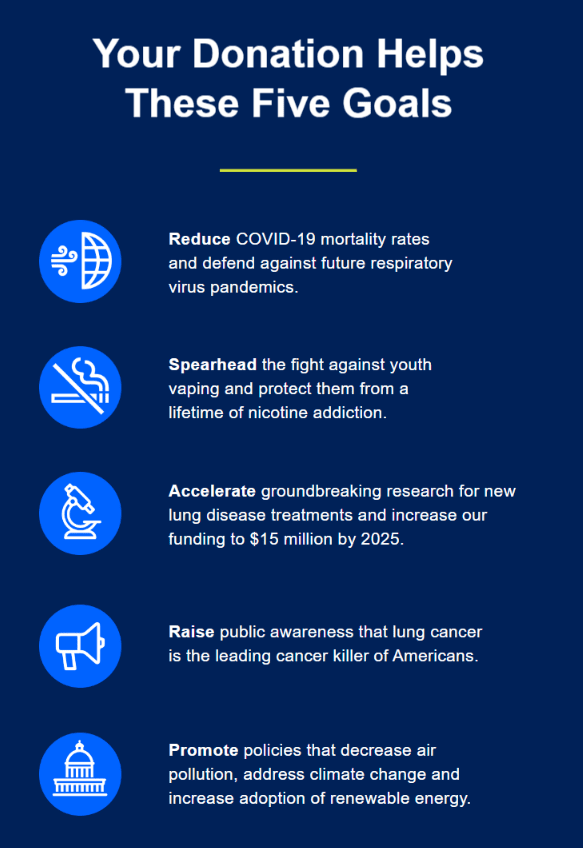
When you tell people the impact of their donation, you’re going to raise more from more donors.
Takeaway: Don’t just ask for money. Tell readers, subscribers, online followers the WHY.
Number 6: It’s the final countdown
A bunch of organizations used countdown clocks at the top of their emails to give me a sense of urgency.
Only 5 hours, 38 minutes, 15 seconds, 14 seconds, 13 seconds… to give!
Countdown clocks in fundraising emails can work. (See here and here for experiments on the subject.) It motivates people to give before time runs out.
One interesting thing I noticed:
All the countdown clocks used by various organization went to 0:00:00 at midnight EST, when GT ended. Only one- the Planned Parenthood timer- kept going until it was also midnight on the west coast.
This is where subscriber and donor segmentation plays a big part. Knowing where people are located allows you to adjust your countdown clock.
But let’s say you don’t know. Why have the clock stop three hours EARLY? Send an email after midnight EST but keep the clock going. Make it clear that for those in Central, Mountain or Pacific time zones, they can still give.
Takeaway: Using a countdown clock can help you raise more money. However, be careful to avoid having every email scream urgency. At some point it loses its effectiveness with readers. They’ll simply tune the urgency out.
P.S. I thought that this would be the final post of this series. However, in two weeks I’m returning with a bonus post. Some wonderful people have shared with me some amazing emails and Giving Tuesday ideas and I want to share them with you.
They have lessons and takeaways for your overall fundraising and marketing efforts.




